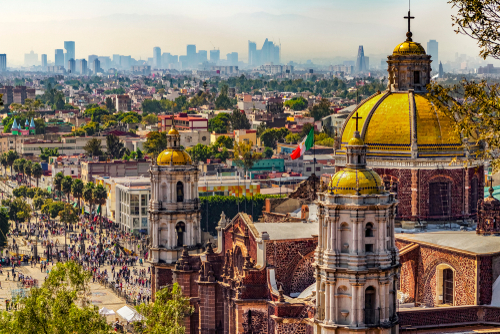Mexico pipeline blast kills 66 and injures dozens more
Mexican authorities now put the number killed in Friday night’s fuel pipeline blast at 66, with scores more injured.
It is believed the explosion occurred after the line was ruptured by suspected fuel thieves in the town of Tlahuelilpan, in Hidalgo state.
Officials say scores of people had been scrambling to fill up containers and were engulfed in an inferno.
Dozens of charred bodies remain at the scene, which is cordoned off by security forces.
What’s the latest on casualties?
The latest updates were delivered by Hidalgo state governor, Omar Fayad, in a morning press briefing alongside President Andrés Manuel López Obrador.
“The toll that we have until a few minutes ago… is 66 dead, while 76 are injured,” Mr Fayad said.
Among the injured were three women and a child of 12, he said.
Distraught relatives are still gathered at the field where the explosion took place.
Forensic experts continue to photograph the remains amid a backdrop of burned clothing and discarded fuel buckets.
Initial reports had said that at least 21 died in the blast.
What exactly happened on Friday?
It is believed fuel thieves drilled through the pipeline. Images before the explosion showed a large jet of liquid rising into the air.
Pemex, Mexico’s state-owned petroleum company, confirmed in a statement that the fire was caused by illegal tapping.
Public Security Minister Alfonso Durazo said the blaze had been extinguished shortly before midnight local time (06:00 GMT).
Some locals criticised security forces at the scene for not warning people more forcibly to get away from the leaking fuel.
Mr Durazo told broadcaster Televisa: “At some point there were too many people there and the army and military personnel withdrew to avoid problems.” That was shortly before the blast occurred.
Some locals said they needed to fill up on fuel.
“A lot of people arrived with their jerry cans, because of the gasoline shortages we’ve had,” resident Martin Trejo told AFP as he looked for his son who had gone to collect fuel.
What is the fuel theft problem?
Fuel theft, known locally as “huachicoleo” (or moonshining) is rampant in some Mexican communities.
The government has said the practice cost the country about $3bn last year.
President López Obrador, who took office in December, has launched a major crackdown. Thousands of marines have been deployed to guard pipelines and transport has been shut down altogether in places.
The policy has led to increased reliance on tanker deliveries and there have been widespread reports of fuel shortages and long lines at petrol stations.
After the blast, Mr Fayad issued a plea on Twitter to try to avoid further disasters.
“I urge the entire population not to be complicit in fuel theft,” Mr Fayad posted (in Spanish). “Apart from being illegal, it puts your life and those of your families at risk. What happened today in Tlahuelilpan should not be repeated.”
Talking to local media after the blast, President López Obrador vowed to press on with his anti-theft policy until it was eradicated.
“Rather than stopping the strategy, the fight against the illegality and theft of fuel, it will be strengthened,” he said.
“The most important thing now is to look after the injured, to save lives, that is the most important thing.”
Pemex has suffered a number of other deadly accidents in the past.
At least 37 people were killed in an explosion at its Mexico City headquarters in 2013 and another 26 died in a fire at a gas facility in 2012.

